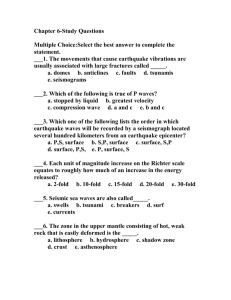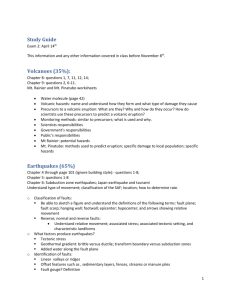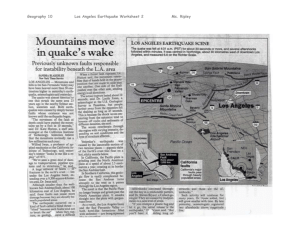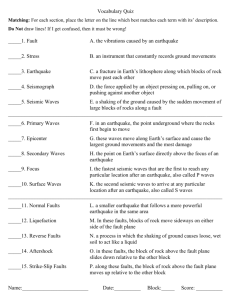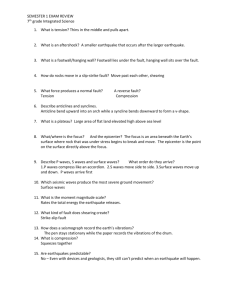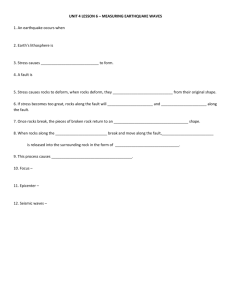Blakeley Jones GEOL 1104 November 2, 2009 Review 5 – Time
advertisement
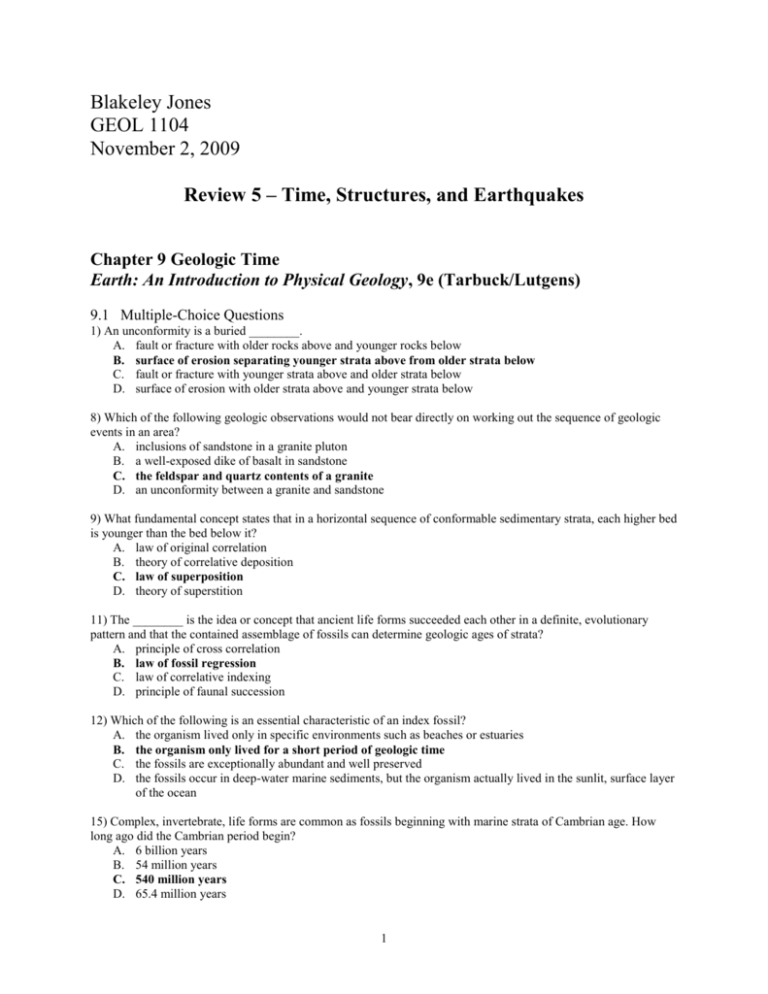
Blakeley Jones GEOL 1104 November 2, 2009 Review 5 – Time, Structures, and Earthquakes Chapter 9 Geologic Time Earth: An Introduction to Physical Geology, 9e (Tarbuck/Lutgens) 9.1 Multiple-Choice Questions 1) An unconformity is a buried ________. A. fault or fracture with older rocks above and younger rocks below B. surface of erosion separating younger strata above from older strata below C. fault or fracture with younger strata above and older strata below D. surface of erosion with older strata above and younger strata below 8) Which of the following geologic observations would not bear directly on working out the sequence of geologic events in an area? A. inclusions of sandstone in a granite pluton B. a well-exposed dike of basalt in sandstone C. the feldspar and quartz contents of a granite D. an unconformity between a granite and sandstone 9) What fundamental concept states that in a horizontal sequence of conformable sedimentary strata, each higher bed is younger than the bed below it? A. law of original correlation B. theory of correlative deposition C. law of superposition D. theory of superstition 11) The ________ is the idea or concept that ancient life forms succeeded each other in a definite, evolutionary pattern and that the contained assemblage of fossils can determine geologic ages of strata? A. principle of cross correlation B. law of fossil regression C. law of correlative indexing D. principle of faunal succession 12) Which of the following is an essential characteristic of an index fossil? A. the organism lived only in specific environments such as beaches or estuaries B. the organism only lived for a short period of geologic time C. the fossils are exceptionally abundant and well preserved D. the fossils occur in deep-water marine sediments, but the organism actually lived in the sunlit, surface layer of the ocean 15) Complex, invertebrate, life forms are common as fossils beginning with marine strata of Cambrian age. How long ago did the Cambrian period begin? A. 6 billion years B. 54 million years C. 540 million years D. 65.4 million years 1 17) What is the age of the Earth accepted by most scientists today? A. 6.4 billion years B. 4.5 million years C. 4.5 billion years D. 6.4 million years 18) Which of the following describes radioactive decay by beta particle emission? A. The atomic number of the daughter isotope is one more than the parent; the mass numbers are the same. B. The mass number of the daughter isotope is one more than the parent and both isotopes have the same atomic number. C. The daughter isotope has an atomic number two less than the parent and a mass number four less. D. The daughter isotope has an atomic number one less than the parent and a mass number two less. 20) Visualize five, horizontal, sedimentary strata exposed in a cliff or canyon wall identified by consecutive numbers, 1 being the lowest bed and 5 being the highest. Which of the following statements concerning the strata are true? A. bed 5 is the oldest B. beds l and 3 are older than bed 4 C. bed 4 is older than bed 2 D. bed 3 is older than beds 2 and 4 21) Which of the following denotes the divisions of the geologic time scale in correct order of decreasing lengths of time beginning with the longest time interval and ending with the shortest? A. eon, era, epoch, period B. era, period, epoch, eon C. eon, epoch, period, era D. eon, era, period, epoch 23) When a radioactive isotope decays by electron capture, the electron ________. A. combines with a neutron in the nucleus, raising the mass number of the daughter isotope by one B. combines with a proton in the nucleus; the atomic number of the daughter is one less than the parent C. makes the parent isotope into an ion with a charge of negative one D. makes the daughter isotope into an ion with a charge of positive one 25) ________ is an erosional contact between tilted, older strata below and horizontal, younger strata above. A. Inverse bedding B. An angular unconformity C. A disconformity D. Cross cutting 27) Sandstone strata and a mass of granite are observed to be in contact. Which of the following statements is correct geologically? A. The sandstone is younger if the granite contains sandstone inclusions. B. The sandstone is younger if it shows evidence of contact metamorphism. C. The granite is older if the sandstone contains pebbles of the granite. D. The granite is older if it contains inclusions of sandstone. 9.3 True/False Questions 1) T or F: The geologic time scale was devised before numerical dating using radioactivity was invented. 2) T or F: Numerical age dates based on radioactivity are very important for studying Proterozoic geologic history because fossils are rare or absent. 2 4) T or F: Most sedimentary rocks are readily dated by radiometric methods. 6) T or F: A disconformity is an erosional unconformity with parallel beds or strata above and below. 7) T or F: Phanerozoic, marine, sedimentary strata of the same age on different continents can usually be correlated by their fossil assemblages. 10) T or F: Pebbles of granite in sandstone and conglomerate resting on the granite suggest that the granite intruded the sedimentary beds. 12) T or F: The Paleocene is the oldest epoch of the Tertiary period. 14) T or F: Strata above an angular unconformity were tilted before the older strata were eroded. Chapter 10 Crustal Deformation Earth: An Introduction to Physical Geology, 9e (Tarbuck/Lutgens) 10.1 Multiple-Choice Questions 2) Which one of the following stress situations results in folding of flat-lying, sedimentary strata? A. horizontally directed; compressive stresses B. vertically directed; extensional or stretching stresses C. horizontally directed; extensional stresses D. vertically directed; compressional stresses 3) Which one of the following is consistent with deformation by folding? A. Horizontal distance is shortened perpendicular to fold axes. B. The crust is thinned. C. The crust is stretched and elongated. D. Horizontal distance perpendicular to fold axes is lengthened. 4) Which one of the following is true for anticlines but not for synclines? A. The limbs dip or are inclined towards the fold axis. B. Some may be asymmetric and some may have plunging axes. C. The deeper strata are buckled upward along the fold axis. D. After erosion, the younger strata are exposed along the axial region of the fold. 6) A ________ fault has little or no vertical movements of the two blocks. A. stick slip B. oblique slip C. strike slip D. dip slip 7) In a ________ fault, the hanging wall block move up with respect to the footwall block. A. normal B. inverse C. reverse D. abnormal 8) In thrust faulting, ________. A. grabens develop on the footwall block 3 B. the crust is shortened and thickened C. horizontal, tensional stresses drive the deformation D. the hanging wall block slips downward along the thrust fault 11) The mountains and valleys of the Basin and Range Province of the western United States formed in response to ________. A. strike-slip faulting and hanging wall block uplifts B. reverse faults and large displacement, thrust faulting C. tensional stresses and normal-fault movements D. normal faulting and horizontal compression 14) In a normal fault ________. A. the hanging wall block below an inclined fault plane moves downward relative to the other block B. the footwall block below an inclined fault plane moves downward relative to the other block C. the hanging wall block above an inclined fault plane moves downward relative to the other block D. the footwall block above an inclined fault plane moves upward relative to the other block 15) A reverse fault is one in which ________. A. the hanging wall block has moved up relative to the footwall block along an inclined fault B. the block above the fault plane has moved backwards with respect to the other block C. one block has moved downward and the other moved horizontally along a vertical fault D. both blocks have moved horizontally in opposite directions along an inclined fault 16) Jointing in rocks is characterized by ________. A. closely spaced, parallel faults along which the blocks have moved in opposite directions B. structures formed where normal and reverse faults intersect C. the hinge lines connecting two limbs of an anticline or syncline D. roughly parallel fractures separating blocks that show no displacement 17) ________ are the products of horizontally directed, tensional stresses. A. Normal faults B. Crustal thickening C. Reverse faults D. Thrust faults 18) ________ in layered sedimentary rocks are evidence for horizontal compression and shortening. A. Normal faults B. Strike-slip faults C. Horsts and grabens D. Tight folds 19) A transform fault is ________. A. a strike-slip fault that forms the boundary between tectonic plates B. a dip-slip fault connecting an anticline with a syncline C. a reverse fault that steepens into a thrust fault D. the rift bounding faults on a mid-ocean ridge 21) Plastic deformation would be favored over brittle deformation in which of the following conditions? A. high confining pressures B. warmer temperatures C. cooler temperatures D. shallow depths 28) Normal and reverse faults are characterized mainly by ________. A. strike slip B. horizontal slip 4 C. dip slip D. basal slip 29) A syncline is ________. A. a fold in which the strata dip away from the axis B. a fold with only one limb C. a fold in which the strata dip toward the axis D. a fold characterized by recumbent limbs 10.3 True/False Questions 1) T or F: Normal faults form in response to horizontal, tensional stresses that stretch or elongate the rocks. 2) T or F: In a reverse fault, the hanging wall block moves up relative to the footwall block. 4) T or F: Horizontal, compressive deformation involves shortening and thickening of the crust. 5) T or F: Along oblique-slip faults, both blocks have horizontal and vertical components of movement. 7) T or F: Plastic deformation occurs more readily in warm rock than in cool rock. 9) T or F: Fractures in rock that have not involved any fault slippage are called joints. Chapter 11 Earthquakes Earth: An Introduction to Physical Geology, 9e (Tarbuck/Lutgens) 11.1 Multiple-Choice Questions 2) Which one of the following statements concerning foci and epicenters is correct? A. The focus is the faulted point on the surface directly above the epicenter. B. The fault first cracks at the epicenter and breaks through to the surface at the focus. C. The epicenter is at the surface directly above the focus where the earthquake initiates. D. The earthquake starts at the focus and the rupture extends down to the epicenter. 3) Which one of the following statements is correct? A. P waves travel through solids; S waves do not. B. P and S waves travel through liquids, but P waves do not travel through solids. C. S waves travel through solids and P waves travel through liquids. D. P and S waves travel through liquids, but S waves do not travel through solids. 4) ________ have the highest velocities. A. Primary waves B. Secondary waves C. Surface waves D. Refracted S waves 5) The ________ is a direct measure of the distance from a seismic receiving station to the focus of a distant earthquake. A. time interval between the first P and S- wave arrivals B. magnitude of the ground acceleration of surface wave passing a receiving station 5 C. time elapsed between the first P-wave arrivals from the first and last aftershocks D. time interval between the first P-wave and the last surface wave 7) On a typical seismogram, ________ will show the highest amplitudes. A. P waves B. S waves C. surface waves D. body waves 8) Which of the following foundation materials is most stable during earthquake shaking? A. bedrock B. unconsolidated moist soil C. water-saturate D. sand and mud 9) The ________ magnitude scale is a measure of the energy released. It does not directly measure the extent of building damage. A. Gutenberg B. Reid C. Mercalli D. Richter 13) Seismic gaps are ________. A. unusually quiet zones along known active faults B. slices of land bounded by active, strike-slip faults on all sides C. inactive faults cutting across high ridges and water gaps D. segments of active faults with creep rates of up to 2 cm/yr 17) The ________ is the point of origination for an earthquake. A. fault point B. focus C. seismic centroid D. epizone 20) P waves ________. A. propagate only in solids B. are faster than S waves and surface waves C. have higher amplitudes than do S waves D. produce the strongest ground shaking 21) The Mercalli Scale is a scale from ________. A. 1 to 12 that rates the energy required for faulting to occur B. 1 to 10 that rates the energy released by an earthquake C. I to XII that rates the structural damage due to an earthquake D. I to X that rates the total energy released during the main quake and all aftershocks 22) What are the smaller magnitude quakes that follow a major earthquake? A. exoshocks B. aftershocks C. hyposhocks D. epishocks 31) The ________ earthquake was accompanied by extensive fire damage. A. Anchorage, 1964 B. San Francisco, 1906 C. Mexico City, 1985 6 D. Yerevan, Armenia, 1988 32) ________ refers to the tendency for a foundation material to lose its internal cohesion and fail mechanically during earthquake shaking. A. Slurrying B. Liquefaction C. Motion slip D. Seismoflowage 11.3 True/False Questions 1) T or F: S waves can travel through solid and liquid media. 2) T or F: The time between the first P-wave and S-wave arrivals is a measure of the distance from a receiving station to the epicenter of the earthquake. 3) T or F: Earthquakes result from the sudden release of elastic strain energy previously stored in rocks surrounding a zone of fault movement. 5) T or F: Following a major earthquake, aftershocks diminish in magnitude but may still be powerful enough to destroy or further damage weakened buildings. 7) T or F: Tsunamis are caused by sudden displacement of large volumes of seawater. 8) T or F: Because their energy dissipates rapidly in deep ocean waters, tsunamis seldom pose any danger to coastal areas far away from the causative earthquake. 9) T or F: The Mercalli earthquake intensity scale uses Roman numerals from I to XII, XII being the highest intensity. 10) T or F: The Richter earthquake magnitude scale is based on the total amount of energy released by the earthquake. 11) T or F: The epicenter of an earthquake is on the surface of the Earth directly above the focus. 13) T or F: Some large earthquakes are preceded by smaller magnitude foreshocks. 15) T or F: Locked fault segments experience slow creep movements, rendering them less likely to host a large magnitude earthquake. 17) T or F: If the P, S, and surface waves arrive almost simultaneously, the seismic recording station is virtually at the epicenter of the earthquake. 19) T or F: On earthquake distribution maps, the boundaries of the Earth's tectonic plates are shown as zones of high seismic activity. 20) T or F: Unconsolidated, water-saturated soils or sediments provide good foundation materials for buildings and other structures. 7
